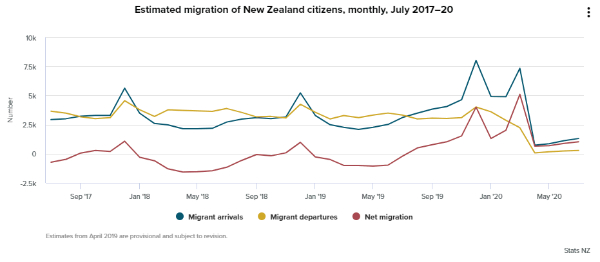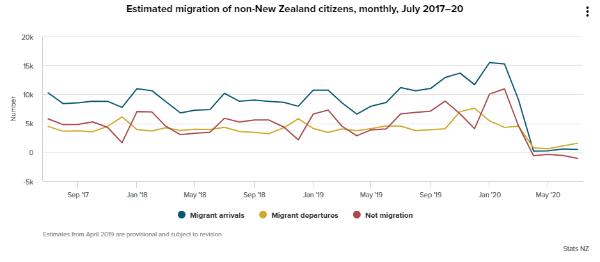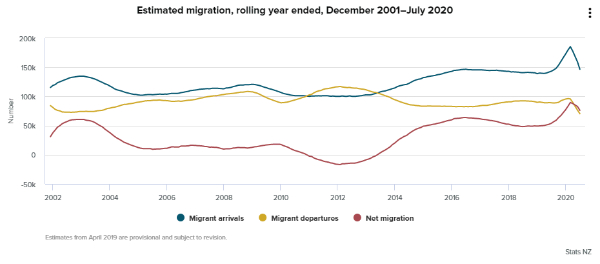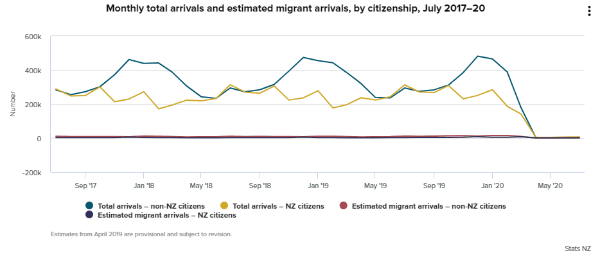Migration Flows Down To A Trickle
COVID-19 travel and border restrictions have reduced migrant arrivals and departures to low levels in recent months, Stats NZ said today.
April to July 2020 were months under full border restrictions imposed by the New Zealand government in response to the COVID-19 pandemic.
New Zealand citizens dominated migrant arrivals during this period, making up a provisionally estimated 4,000 migrant arrivals. For migrant departures of New Zealand citizens, the number was provisionally estimated at 800.
“Monthly migrant flows of New Zealand citizens are well below levels in previous years,” population indicators manager Tehseen Islam said.
“Border and travel restrictions, along with capacity constraints in managed isolation and quarantine facilities, have limited people’s ability to travel.”

“The current net gain of New Zealand citizens is a combination of people choosing to return from overseas, and New Zealand citizens who may have been unable or reluctant to head offshore due to international travel restrictions and the evolving global pandemic,” Mr Islam said.
July 2020 is the 12th consecutive monthly net gain of New Zealand citizens. This reverses the typical historical pattern where more New Zealand citizens depart than arrive.
In contrast, there was a net loss of non-New Zealand citizen migrants each month from April to July 2020. This is the first period of net losses of non-New Zealand citizens in the outcomes-based migration estimates, available from 2001 onwards.
From April to July 2020, overall net migration was provisionally estimated at 800, made up of a net gain of 3,300 New Zealand citizens, and a net loss of 2,500 non-New Zealand citizens. Across the same four months in 2019, there was a provisionally estimated net gain of 14,200 migrants.

Pre-lockdown arrivals lift annual migration
Despite low migration in recent months, provisional estimates for the year ended July 2020 show annual net migration at 76,200. This consisted of 56,700 non-New Zealand citizens and 19,500 New Zealand citizens.
“Ninety-nine percent of the overall net migration gain in the year ended July 2020 occurred in the eight months leading up to travel and border restrictions,” Mr Islam said.
“In the last four months the net migration gain was only 800.”
“Many people who arrived in New Zealand in late-2019 and early-2020 have not yet returned overseas, and are staying longer than usual.”
As people stay longer, they are more likely to be counted as a migrant arrival. The ongoing stay of people who arrived before border and travel restrictions, is keeping annual net migration estimates at high levels.
Net migration estimates could be revised up or down depending on whether these people stay in New Zealand or head back overseas.

Low travel in recent months
On average, there were 7,600 arrivals and 19,000 departures in each month from April to July 2020. These are well below averages for the same period in 2019, when there were 526,000 arrivals and 555,500 departures each month.
From April to July 2020, 2 in every 3 arrivals was by a New Zealand citizen, and 6 in every 7 departures was by a non-New Zealand citizen.
Almost all border crossings are by short-term travellers. From April to July 2019, about 1 in 60 people who crossed the border was provisionally a migrant, compared with 1 in 10 in the same period in 2020. This change is mostly due to the large decrease in short-term travel volumes.

Who is a migrant?
‘Migrant arrivals’ are overseas residents, including New Zealand citizens living overseas, who cumulatively spend 12 of the next 16 months in New Zealand after arriving.
‘Migrant departures’ are New Zealand residents, including non-New Zealand citizens living in New Zealand, who cumulatively spend 12 of the next 16 months out of New Zealand after departing.
Migrant arrivals and departures include the flows of New Zealand citizens as well as the flows of non-New Zealand citizens as both affect the population living in New Zealand.
The classification of travellers as migrants is based on their time spent in and out of New Zealand, not what visa type or passport they cross the border on, and not on their responses on arrival cards. Given this, we need to observe up to 16 months of travel history, using the 12/16-month rule, to definitively classify a border crossing as a migrant movement. Border crossing data after June 2020 therefore informs the latest migration estimates.
Key travel restrictions timeline
2 February 2020
New Zealand Government placed entry restrictions into New Zealand on all foreign nationals travelling from or transiting through mainland China (see New Zealand to restrict travel from China to protect against coronavirus).
2 March 2020
Travel restrictions for China and Iran to continue, and people entering the country from South Korea and northern Italy told to go into self-isolation (see Travel restrictions reconfirmed as precaution against COVID-19).
14 March 2020
Every person entering New Zealand from anywhere in the world required to self-isolate for 14 days, excluding the Pacific.
19 March 2020
New Zealand’s borders closed to almost all travellers, except for returning New Zealanders (see Stronger border measures to protect NZers from COVID-19) and New Zealanders advised not to travel overseas (see New Zealanders advised not to travel overseas).
24 March 2020
Tens of thousands of New Zealanders travelling overseas advised to shelter in place (see New Zealanders overseas encouraged to shelter in place ).
2 April 2020
New Zealand Government announced that domestic travel restrictions would be relaxed to facilitate the departure of overseas visitors (see Managed departure plan for stranded foreign nationals enables safe, orderly exit).
7 April 2020
New Zealand Government announced New Zealand to enter into transit arrangements with a number of countries to make it easier for each other’s citizens to get home (see Managed transit allows stranded travellers to get home).
9 April 2020
New Zealand Government announced mandatory 14 day quarantine for all arrivals (see Prime Minister’s remarks halfway through Alert Level 4 lockdown).
7 July 2020
New Zealand Government announced bookings on incoming Air New Zealand flights to be managed to align arrival numbers with capacity available in managed isolation and quarantine facilities (see Government and Air New Zealand agree to manage incoming bookings).


 Gordon Campbell: On What’s Wrong With The Treaty Principles Bill
Gordon Campbell: On What’s Wrong With The Treaty Principles Bill Mana Mokopuna: Children And Young People Share Vital Insights On Healing From Family Violence And Sexual Violence In New Report
Mana Mokopuna: Children And Young People Share Vital Insights On Healing From Family Violence And Sexual Violence In New Report NZ Government: PM Marks One Year In Government
NZ Government: PM Marks One Year In Government Helen Clark Foundation: Helen Clark Foundation Calls For Political Action To Reduce The Prevalence Of Junk Food And Improve Health Outcomes
Helen Clark Foundation: Helen Clark Foundation Calls For Political Action To Reduce The Prevalence Of Junk Food And Improve Health Outcomes Justice Committee: Further Decisions About Submissions Process For The Principles Of The Treaty Of Waitangi Bill
Justice Committee: Further Decisions About Submissions Process For The Principles Of The Treaty Of Waitangi Bill Infrastructure New Zealand: Single Agency Needed To Coordinate Climate Adaptation And Recovery
Infrastructure New Zealand: Single Agency Needed To Coordinate Climate Adaptation And Recovery Free Speech Union: Fair Digital News Bargaining Bill Likely To Restrict Access To Information, Polling Shows Most Oppose
Free Speech Union: Fair Digital News Bargaining Bill Likely To Restrict Access To Information, Polling Shows Most Oppose


